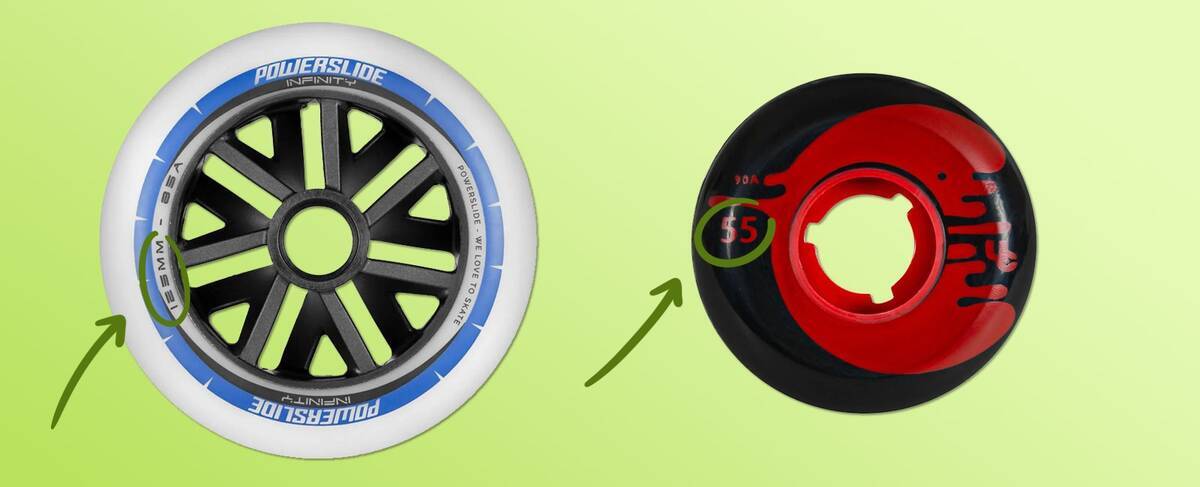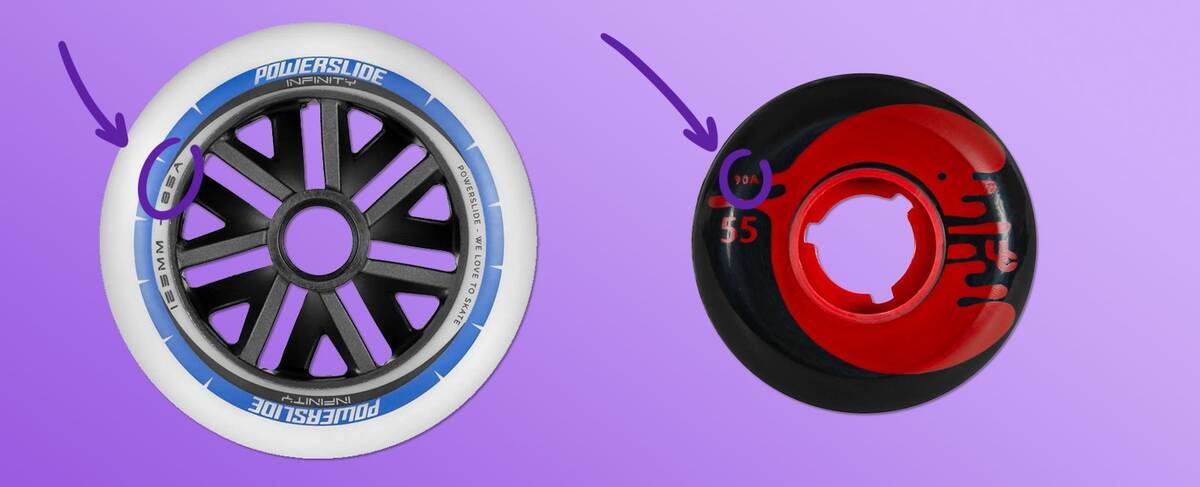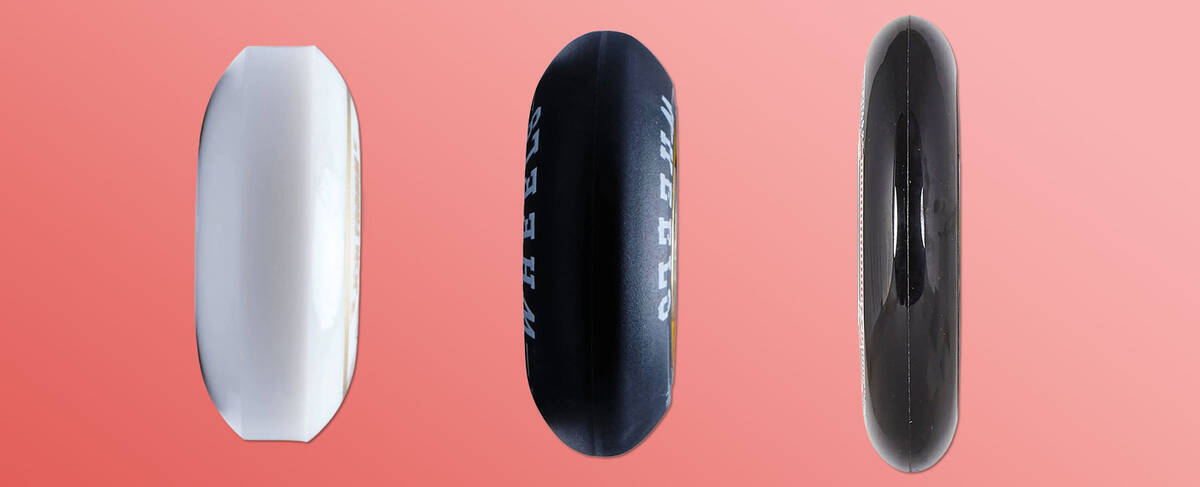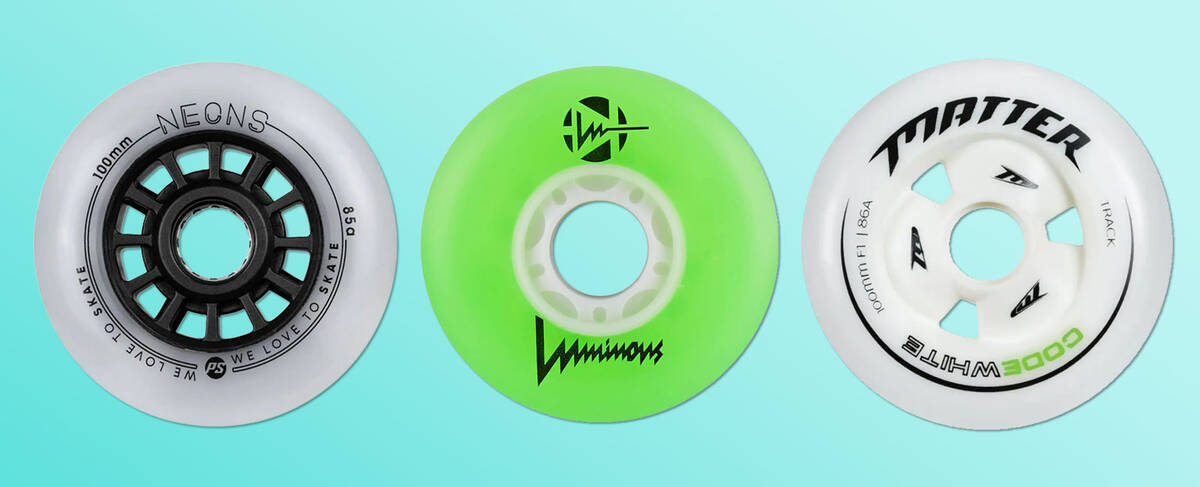A Complete Guide to Wheels for Inline Skates

- Wheel size: Influences speed and nimbleness.
- Durometer: Denotes wheel hardness – impacts speed and vibration absorption.
- Rebound: Describes how fast the wheel returns to its shape after compression.
- Grip: Determines the wheel's ability to adhere to surfaces.
- Wheel profile: Influences speed and steadiness.
Overview
Overview
Which Inline Skate Wheels Are Best for You?

Identifying the appropriate inline skate wheels is more straightforward when you know what type of wheel aligns with your skating style.
Regardless of your inline skating style, you'll need to consider wheel size and hardness and how these correlate with the surfaces you'll be skating on.
| Inline Skating Style | Properties | Size Range / Hardness Range |
| Fitness Skate Wheels |
Seamless roll Energy transfer
|
80-110 mm 80A-88A |
| Freeskate Wheels |
Swift and manoeuvrable |
75-110 mm 84A-88A |
| Aggressive Skate Wheels |
Durable and shock-absorbent Compact size Flat or rounded profiles |
55-80 mm 88A-95A |
| Roller Hockey Wheels |
Agile with good grip Excellent acceleration Some tailored for indoor use |
65-84 mm 72-84A
|
| Speed Skate Wheels |
Optimal speed Suited for various environments |
100 mm-125 mm 83A-90A |
How Can Inline Skate Wheels Be Compatible?

Inline skate wheels typically have a standard width of 24 mm, simplifying the task of finding wheels that fit your inline skates. Any wheel that is the same size or smaller than the maximum diameter allowed for your rollerblade frames can be used.
By understanding the details such as hardness, rebound, grip, and profile, you can select wheels that not only fit your skates but also improve their performance.
Continue reading for more insights, or proceed directly to our collection:
Understanding Inline Skate Wheel Diameter

The diameter of an inline skate wheel is specified in millimetres (mm) and is usually labelled on the wheel's side. If uncertain, you can measure the diameter yourself.
The diameter affects how the wheels behave. Aspects such as acceleration, velocity, agility, and directional stability all change with the size of your wheels.
Below is how wheel diameter impacts inline skate performance:
- Smaller diameter: Enhanced acceleration and simpler control.
- Larger diameter: Greater top speeds and improved directional stability.
The suggested diameter differs according to skating style. In the chart below, you’ll find our general suggestions for each style of inline skating:
Inline Skate Wheels Size Chart
| Inline Skating Style | Size Range |
| Aggressive Skate Wheels | 55-80 mm |
| Roller Hockey Wheels | 65-84 mm |
| Fitness Skate Wheels | 80-110 mm |
| Freeskate Wheels | 75-110 mm |
| Speed Skate Wheels | 100-125 mm |
Inline Skate Wheel Hardness - Durometer Explained

The hardness of inline skate wheels is typically indicated by durometer, a standard method used to gauge the hardness of substances like rubber and other polymers. The A-scale is commonly used for rollerblade wheels, shown by a number followed by an A (e.g., 82A) where a higher number means a harder wheel.
The A-scale simplifies recognising the hardness of different wheels, and it's often indicated on the wheel itself.
Your ideal wheel hardness is dependent on your skating style. Below is a chart with our general guidelines for selecting the correct hardness for your inline skating style:
Inline Skate Wheels Hardness Chart
| Inline Skating Style | Hardness Range |
| Aggressive Skate Wheels | 88A-95A |
| Roller Hockey Wheels | 72A-84A |
| Fitness Skate Wheels | 80A-88A |
| Freeskate Wheels | 84A-88A |
| Speed Skate Wheels | 83A-90A |
Wheel hardness affects performance on various surfaces and conditions. Always consider the hardness when purchasing wheels, as it plays a critical role in performance.
Comparing Hard and Soft Inline Skate Wheels
Understanding how hardness impacts wheel performance is crucial, especially if deciding between two wheels with varying hardness levels.
Performance impacts due to wheel hardness on your rollerblades:
Advantages of harder wheels- Increased speeds
- Higher durability
- Reduced grip
- Poor vibration absorption
- Increased grip
- Better shock absorption
- Lower speeds
- Reduced durability
The typical rule for inline skate wheels is that softer wheels better absorb vibrations and provide improved grip. In contrast, harder wheels offer less vibration absorption and grip.
Alternative Hardness Scales
Some brands assess rollerblade wheel hardness using the footprint scale. Here's how footprint scale information equates to the A-scale:
- F0 - approximately 88A
- F1 - approximately 85A
- F2 - approximately 84A
- F3 - approximately 83A
Inline Skate Wheels - Understanding Rebound
The term rebound refers to how well a wheel regains its shape after being compressed. With each stride, the wheel compresses, and a high-rebound wheel swiftly returns, enhancing speed. Conversely, low-rebound wheels absorb rather than transfer energy from strides, thus reducing speed. Therefore, rebound is crucial to the velocity of your skating.
High-rebound features are often found in superior quality wheels. Many companies label such wheels as SHR urethane, standing for Super High Rebound. There's no universal metric to assess rebound, but generally, cheaper wheels have less compared to expensive offerings from renowned manufacturers.
Grip Considerations for Inline Skate Wheels
The grip of inline skate wheels is largely affected by the polyurethane (PU) compound in the wheel's rubber, with hardness being a major factor.
The relationship between wheel grip and hardness is as follows:
- Softer wheels: Greater grip.
- Harder wheels: Reduced grip.
The riding surface dictates how well a wheel grips. For slick surfaces like rinks or indoor skateparks, stronger grip is necessary to avoid slipping. On rougher textures like asphalt, grip is less concerning.
On rougher terrains, you can choose relatively harder wheels without worrying about traction loss.
Inline Skate Wheels - Profiles

Inline skate wheels have diverse profiles from flat to pointed. A wheel's profile dictates the point of contact's width with the surface. A flat profile offers a larger contact patch, while pointy wheels have smaller ones.
Pointy profiles suit various styles, from fitness to speed skates, due to their reduced friction, which is ideal for speed. These profiles are prevalent due to versatility and efficient speed properties.
Flat profile wheels support stability, benefiting trick landings in aggressive skating but aren’t the swiftest option.
Rounded profiles suit both freeskating and aggressive setups, often seen in flat configurations. They handle better than pointed wheels, ideal for beginners needing easier control.
Discovering the Hubs of Inline Skate Wheels

The hub is the central component of a wheel, anchoring the bearings. Made of hard plastic or aluminium, aluminium hubs are generally heavier but offer greater durability and resistance to impacts.
Main hub categories for inline skate wheels include:
- Solid core: High strength but heavier.
- Spoked core: Lightweight but less enduring.
- Hollow core: Balanced between weight and durability.
For best efficiency, inline skate wheels should be strong and durable while maintaining low weight, aiding energy conservation when lifting skates.
Maintaining Your Inline Skate Wheels
Enhancing the longevity of wheels is advisable, as they wear out faster than other skate parts. Careful planning could preserve them, saving costs. Routinely rotating wheels extends their lifespan and maintains optimal performance.
Ordinarily, wheels wear into a flat shape along the inside of the skates. This isn't helpful for technique, and if observed, it's time to rotate them.
Regularly turning the wheels on your rollerblades can help maintain the wheels' uniform shape. We suggest consulting our guidance for anyone uncertain about the process:
If you’re unsure whether it's the right time to replace the wheels on your inline skates, you should have a look at our guide covering this topic:
For those requiring assistance with wheel mounting, here’s the information you need:
If you seek advice on general inline skate upkeep, we offer a comprehensive online guide here:
... How About Bearings?
We have dedicated guides specifically for wheel bearings. This guide provides all the necessary information about their function:
If your glide lacks its former smoothness, the bearings may not be in optimal condition. Consider giving them a good clean and reapplying lubricant:


